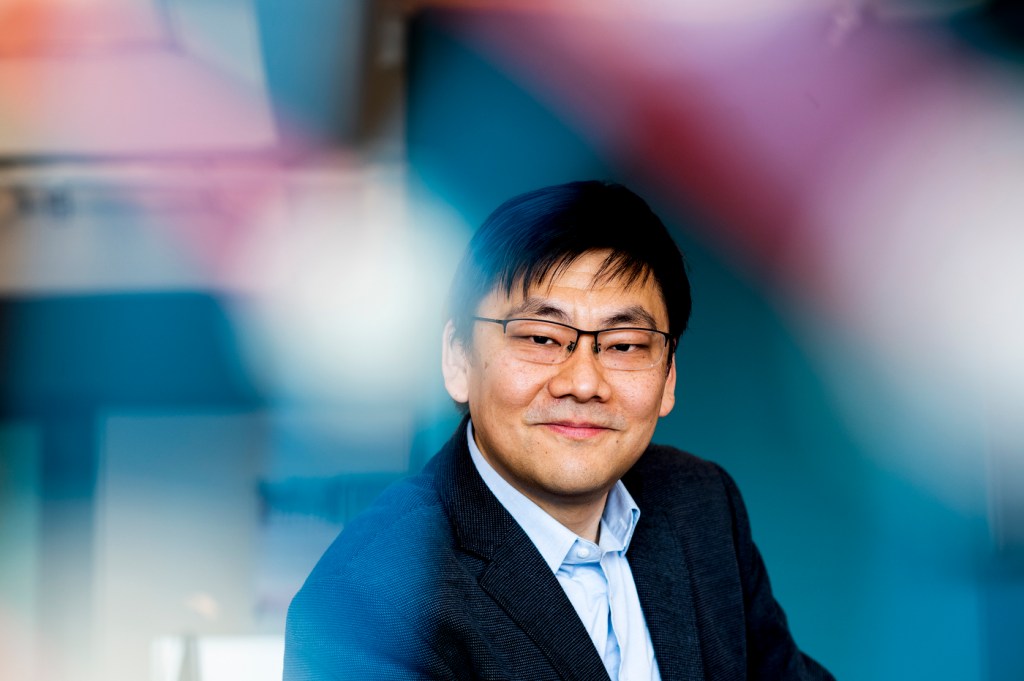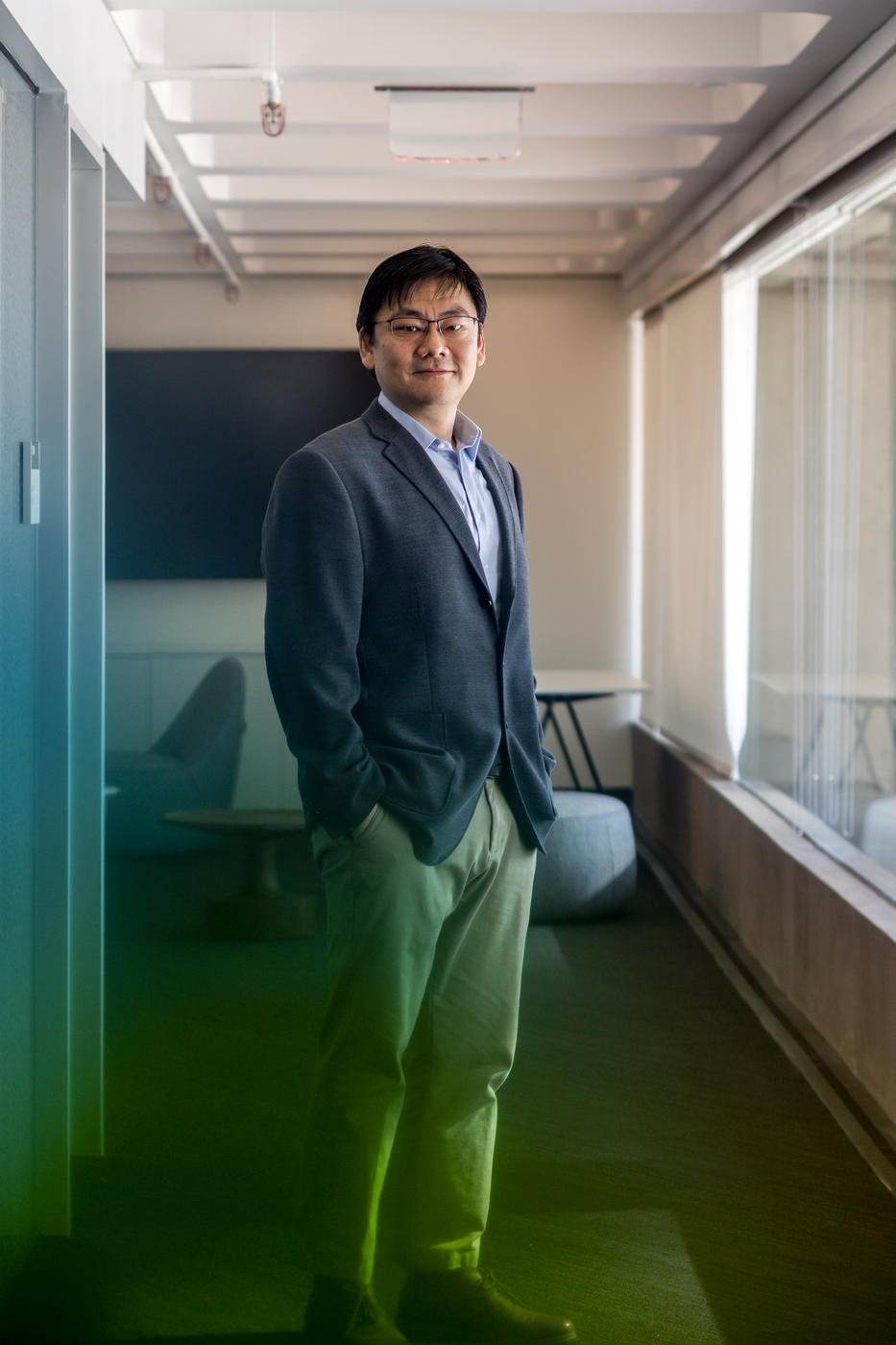For Max Bi, physics + biology = a Sloan Research Fellowship

Dapeng (Max) Bi, a physicist, was initially drawn to biology after his PhD. A dozen years later, his work straddling the two disciplines has earned Bi a Sloan Research Fellowship.
Bi is among 118 early-career scientists and scholars across a wide variety of disciplines to receive fellowships this year from the Alfred P. Sloan Foundation. He is the 12th Northeastern faculty member to earn the prestigious award, which has recognized 53 eventual Nobel Prize winners and 17 fellows who have won the Fields Medal in mathematics.
Bi’s multidisciplinary research, which offers insight on the treatment of cancer, asthma, and other diseases, is contributing to the evolution of theoretical and computational physics.

Bi’s multidisciplinary research offers insight on the treatment of cancer, asthma, and other diseases. Photo by Alyssa Stone/Northeastern University
“That’s a strength of Northeastern’s physics department,” says Bi, an assistant professor of physics. “We recognize that modern science is defined by the problem and not by the discipline, and tackling these problems requires interdisciplinarity. I think Northeastern is doing very well in that area.”
Fellows are awarded $75,000 for research-related expenses. Bi plans to use the award to support doctoral students in his research group, enabling them to attend in-person conferences and workshops after two years of remote participation prompted by the COVID-19 pandemic.
“It’s a big boost to my own morale, and hopefully to the morale of my group,” Bi says of the Sloan award. “Even though we don’t work in a physical laboratory, the pandemic has hit us quite harshly. I hope this shows them that what we are working on is highly impactful.”
Bi’s interest in the behavior and movement of cells was launched by his PhD study of granular physics.
“I started to work with biological cells, which of course are much more complicated than the nonliving granular materials,” he says. “That was when I started to learn more biology, and to apply the tools of physics to biology.”
Human cells cluster together to form stable, protective layers, which Bi refers to as a “jammed” state—as though the cells were stuck in a traffic jam.
“But under other conditions—such as cancer, or asthma attacks, or a wound that injures the skin—the cells are no longer stuck together,” Bi says. “They begin to move around. It’s very much like when a traffic jam starts to move, when the traffic starts to flow. We’ve been calling that state ‘unjammed.’”
What causes cancer cells to metastasize and move to other areas of the body? Bi and his team have created a simple metric that identifies the cells that are more likely to migrate: A ratio between the perimeter of the cell and its area.
“If that ratio—that number—falls below a certain precise value, then it’s ‘jammed,’” Bi says. “If it’s above that value, it’s ‘unjammed.’ We call that value the ‘cell shape index’.”
The cell shape index has been verified across a wide range of cells—in humans and animals, and even in fruit flies—in tests conducted with Jeff Fredberg and Jin-Ah Park at Harvard School of Public Health. In each case, the size of the cell proved to be indicative of its inclination to move.
Other tests conducted with Ming Guo at MIT have affirmed another of Bi’s theories, that the behavior of cells is affected by curved surfaces—such as an airway or a lung.
Bi’s curiosity has led him on an “exhilarating journey” that also encompasses materials science and medicine, says Alain Karma, a CAS Distinguished Professor in physics and director of the Center for Interdisciplinary Research on Complex Systems (CIRCS).
“In the biological realm, Max’s research focuses on understanding how groups of cells work together to accomplish vital tasks,” Karma says. “One example is wound healing, which requires cells to regenerate and move to a specific location to repair damaged tissue. Another is morphogenesis, which refers to the orchestrated movement of individual cells and cell sheets during organ development. Max’s research has shed new light on how cells interact with each other and their environment through chemical signals and mechanical forces to collectively achieve those seemingly miraculous tasks.”
Bi’s findings have a variety of applications, says Erin Cram, associate dean for research in biology at Northeastern.
“Among other things, his work is helping us understand how mechanical cues like tissue stiffness are sensed and interpreted by cells,” says Cram. “Cells behave very differently in different environments, and understanding this is critical for designing therapies for promoting wound healing and, conversely, blocking cells from migrating out of a tumor. As a cell biologist, I am excited to see physicists like Max applying their knowledge, quantitative and modeling skills, and deep insights to biological problems.”
Bi is excited about continuing his research along a variety of lines, including biology-inspired designs for exotic materials that can manipulate sound or light.
“I’m deeply honored to receive this award,” he says. “To be recognized by my peers is very special, and this would not have been possible without the hard work of my group members and the support of my mentors and colleagues at Northeastern and beyond.”
For media inquiries, please contact media@northeastern.edu.






